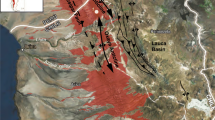Abstract.
The late Pleistocene trachytic Campanian Ignimbrite underlies much of the Campanian Plain near Naples, Italy, and occurs in valleys in the mountainous area surrounding the plain out to about 80 km from its source, the Campi Flegrei caldera. At sites within 15 km of the Campi Flegrei, anisotropy of magnetic susceptibility (AMS) principal directions indicate that, in the absence of significant topography, deposition came from a flow moving in a roughly radial direction. AMS studies of the more distal ignimbrite reveal downhill and/or downvalley flow directions prior to deposition, even where these directions are at high angles to a generally radial transport direction from the vent. On the flanks of Roccamonfina Volcano, flow was directly downhill, as if the source of the ignimbrite was the summit of the volcano. In most localities, the ignimbrite consists of a single massive deposit. In a few localities in the Apennine Mountains, however, the confluence of multiple drainage systems off mountains resulted in multiple local flow units that cannot be correlated between valleys. A detailed study of the ignimbrite in the flat Titerno River valley near Massa shows that the AMS fabrics are not due to late-stage creeping during deposition or compaction. Well-defined, but non-parallel AMS fabrics from vertical and lateral sections in the Massa area are best explained by the merging of gravity currents flowing down the valley and steep valley sides to form a single aggradational deposit. Clast compositions and AMS axes at Mondragone indicate that the pyroclastic flow encountered the Monte Massico massif and was partially blocked, so that flow during deposition was toward the Campi Flegrei. Similar AMS data from sites along the edge of the Campanian Plain indicate back-flow off the first ridge of the Apennine Mountains reached at least 5 km from their base. The Campanian Ignimbrite was deposited from a density-stratified pyroclastic flow. The depositional system consisted of the lower, denser portion of the current, and was controlled by topography. The grouping of the AMS axes is interpreted to indicate that deposition occurred under laminar flow conditions.
Similar content being viewed by others
Author information
Authors and Affiliations
Additional information
Electronic Publication
Rights and permissions
About this article
Cite this article
Ort, M.H., Orsi, G., Pappalardo, L. et al. Anisotropy of magnetic susceptibility studies of depositional processes in the Campanian Ignimbrite, Italy. Bull Volcanol 65, 55–72 (2003). https://doi.org/10.1007/s00445-002-0241-2
Received:
Accepted:
Published:
Issue Date:
DOI: https://doi.org/10.1007/s00445-002-0241-2




